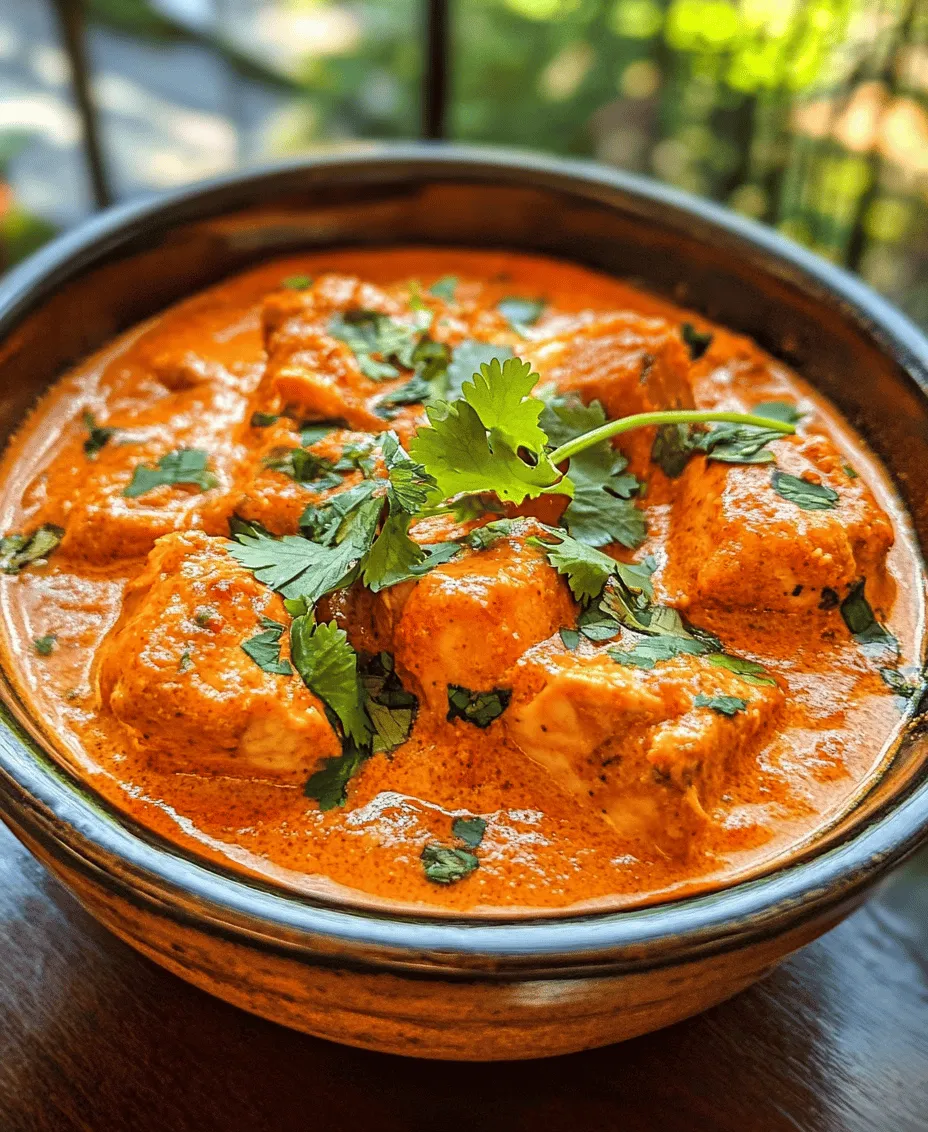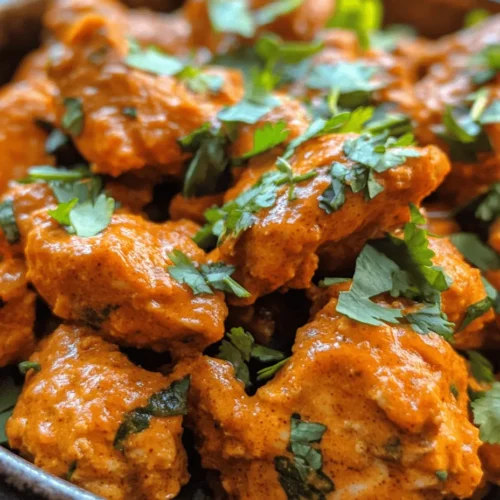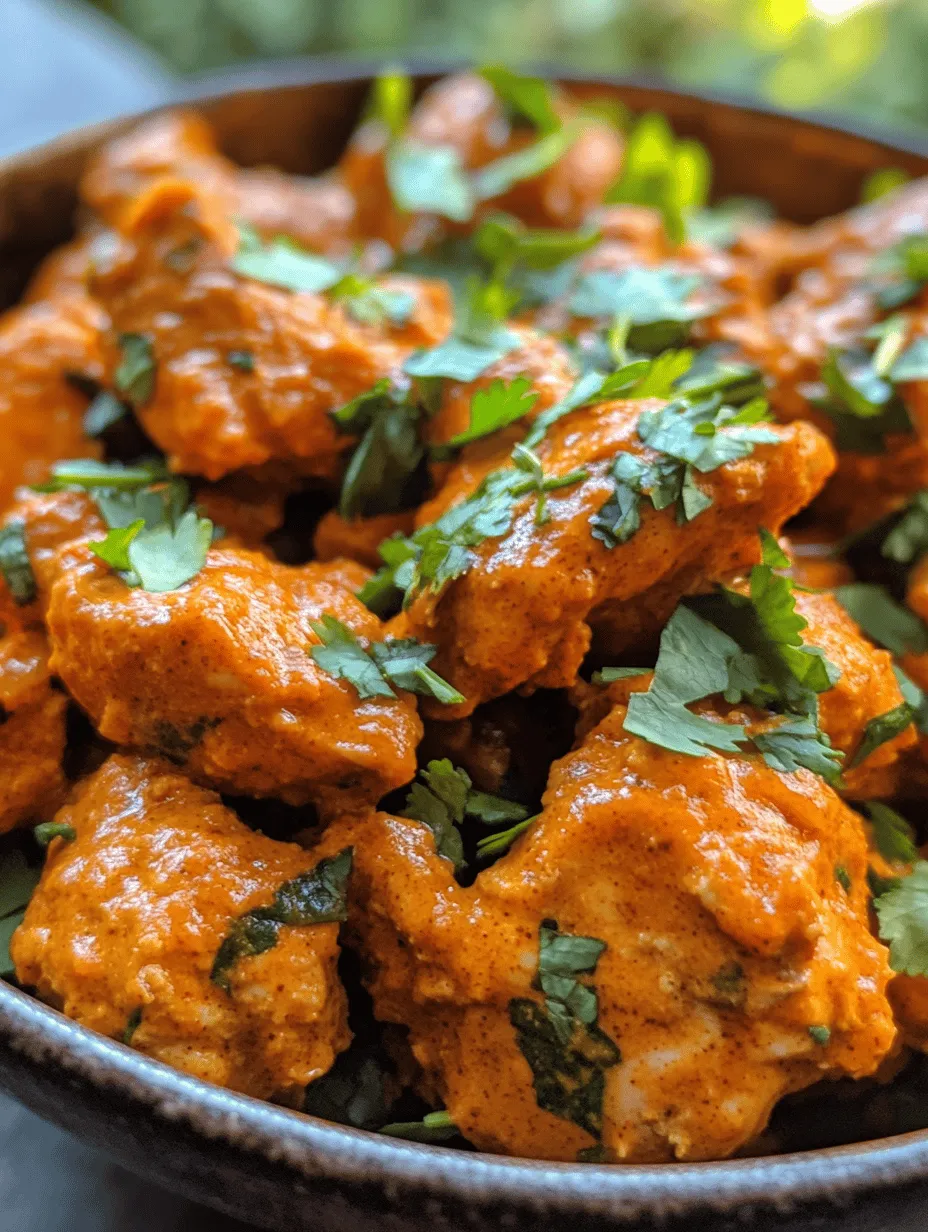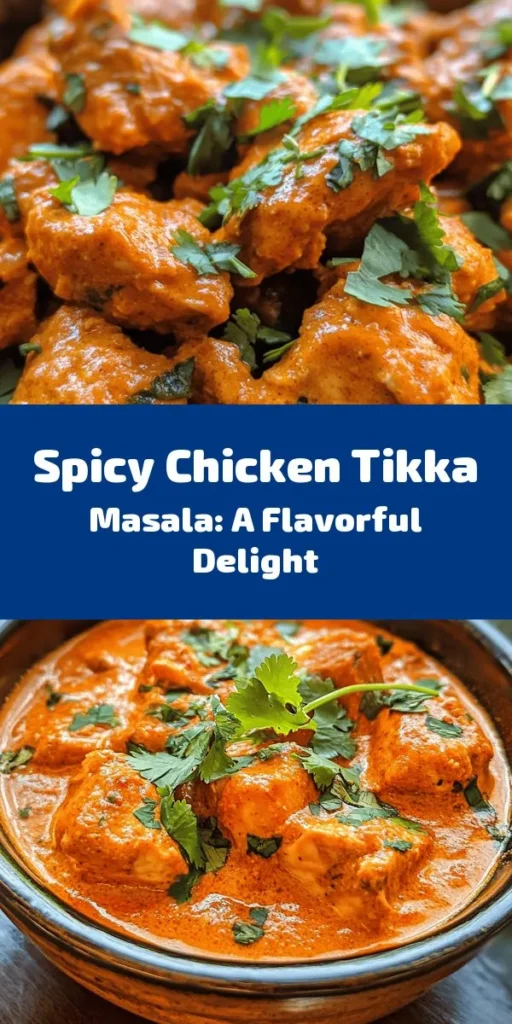Introduction
If you’re on the lookout for a dish that encapsulates the essence of Indian cuisine, look no further than Chicken Tikka Masala. This culinary masterpiece has transcended borders, becoming a beloved staple not only in Indian households but also in restaurants and homes around the world. Its rich, spicy flavors, combined with tender marinated chicken, create a delightful experience for the palate, inviting you to savor every bite.
The allure of Chicken Tikka Masala lies in its complexity. It is a dish that marries a symphony of spices, a medley of textures, and a tantalizing aroma that can instantly transport you to the vibrant streets of India. Whether you enjoy it with fragrant basmati rice or warm naan, this dish is a celebration of the hearty, rich flavors that define Indian culinary traditions.
In this article, we will delve into the intricacies of preparing Spicy Chicken Tikka Masala Delight. This recipe not only showcases the traditional methods of cooking but also highlights the significance of each ingredient in enhancing the overall flavor profile. By the end of this guide, you will be equipped with the knowledge and techniques needed to recreate this beloved dish in your own kitchen, making it a go-to favorite for family dinners or special occasions.
Understanding the Ingredients
One of the most critical aspects of creating a memorable Chicken Tikka Masala lies in understanding its ingredients, especially the marinade that infuses the chicken with flavor. Marination is not just a step; it is an art form that requires time and attention to detail. The key to a succulent and flavorful chicken tikka is allowing the spices and yogurt to work their magic, transforming ordinary chicken into something extraordinary.
Importance of Marination in Flavor Development
Marination is a crucial step in preparing Chicken Tikka Masala. It involves soaking the chicken in a mixture of yogurt and spices, allowing the flavors to penetrate the meat and tenderize it. The longer the chicken marinates, the more pronounced the flavor becomes. This process not only enhances the taste but also ensures that the chicken remains juicy and flavorful during the cooking process.
Breakdown of Key Ingredients in the Chicken Marinade
Yogurt: Tenderizing Agent and Flavor Enhancer
At the heart of the marinade is yogurt, a staple in Indian cooking. Yogurt serves two primary purposes: it acts as a tenderizing agent, breaking down the proteins in the chicken, and it enhances the overall flavor profile of the dish. The acidity of the yogurt works in harmony with the spices, creating a rich base that ensures every bite is bursting with flavor.
Spices: Garam Masala, Cumin, Paprika, Turmeric, Chili Powder
The spice blend is what truly defines Chicken Tikka Masala. A combination of garam masala, cumin, paprika, turmeric, and chili powder creates a complex flavor profile that is both aromatic and spicy.
– Garam Masala: A quintessential Indian spice blend, garam masala adds warmth and depth to the dish.
– Cumin: Known for its earthy flavor, cumin complements the other spices beautifully and adds a hint of smokiness.
– Paprika: This spice not only contributes a vibrant color to the dish but also adds a subtle sweetness.
– Turmeric: Beyond its health benefits, turmeric introduces a warm yellow hue and a mild, earthy flavor.
– Chili Powder: Adjust the heat level according to your preference; chili powder adds the desired spiciness that makes this dish memorable.
Fresh Ingredients: Garlic and Ginger for Authentic Taste
No Indian dish is complete without the robust flavors of garlic and ginger. These fresh ingredients not only enhance the taste but also provide a fragrant aroma that is characteristic of Indian cooking. Minced garlic and ginger should be added to the marinade, ensuring that each piece of chicken is enveloped in their zesty goodness.
Overview of the Tikka Masala Sauce Components
After marinating the chicken, the next step is to prepare the tikka masala sauce. This sauce is what brings the dish together, enveloping the chicken in a creamy, rich blend of flavors.
Role of Tomatoes and Cream in Creating a Rich Sauce
The base of the tikka masala sauce typically includes tomatoes, which provide acidity and sweetness, balancing the spices perfectly. Fresh or canned tomatoes can be used, but for an authentic taste, opt for ripe tomatoes that lend their natural sweetness to the dish.
Cream is another essential component, adding richness and smoothness to the sauce. The combination of tomatoes and cream creates a luxurious texture that complements the spiced chicken beautifully.
Importance of Aromatics like Onions and Garlic
Aromatics play a crucial role in building the flavor of the tikka masala sauce. Onions are usually sautéed until golden brown, releasing their natural sweetness and flavor. Adding garlic at this stage allows it to infuse the oil, enhancing the overall taste of the sauce. The interplay between the sweetness of the onions and the sharpness of the garlic forms a solid foundation for the rest of the ingredients.
The Art of Marinating Chicken
Now that we understand the importance of the marinade and its key components, let’s dive into the art of marinating chicken.
Detailed Steps for Marinating Chicken
1. Choose the Right Chicken: For the best results, opt for chicken thighs rather than chicken breasts. Thighs are juicier and more forgiving during the cooking process, ensuring that your tikka masala remains moist and flavorful.
2. Prepare the Marinade: In a large bowl, combine yogurt, minced garlic, minced ginger, garam masala, cumin, paprika, turmeric, and chili powder. Mix well to create a smooth paste.
3. Coat the Chicken: Add the chicken thighs to the marinade, ensuring that each piece is thoroughly coated. Use your hands to rub the marinade into the chicken for maximum flavor absorption.
4. Cover and Refrigerate: Once the chicken is well-coated, cover the bowl with plastic wrap or transfer the mixture to a resealable bag. Refrigerate for at least 1 hour, but ideally, allow it to marinate overnight. This extended time will intensify the flavors and ensure a tender result.
Recommended Marination Time for Optimal Flavor
While a minimum of one hour is essential for flavor development, marinating the chicken overnight is highly recommended. The longer the chicken sits in the marinade, the more tender and flavorful it becomes. This not only enhances the taste but also ensures that the chicken can withstand the high heat of cooking without drying out.
Tips for Selecting the Best Chicken Thighs for This Recipe
When selecting chicken thighs for your Chicken Tikka Masala, consider the following tips:
– Bone-In vs. Boneless: Bone-in thighs retain moisture and flavor better than boneless; however, boneless thighs are easier to handle and cook faster. Choose based on your preference.
– Organic vs. Conventional: If possible, opt for organic chicken, which is raised without antibiotics and hormones, providing a cleaner flavor.
– Freshness: Always choose fresh chicken over frozen when possible, as fresh meat will yield better results, especially in terms of texture and flavor.
Cooking Methods for Chicken Tikka
Once the chicken has marinated to perfection, it’s time to cook it. There are several methods for preparing Chicken Tikka Masala, but two of the most popular are oven roasting and grilling.
Oven Roasting: Step-by-Step Guide
1. Preheat the Oven: Preheat your oven to 425°F (220°C). A hot oven ensures that the chicken cooks quickly while achieving a nice char.
2. Prepare a Baking Tray: Line a baking tray with aluminum foil or parchment paper for easy cleanup. Place a wire rack over the tray to allow for even cooking and to catch any drippings.
3. Arrange the Chicken: Remove the chicken from the marinade, allowing any excess to drip off. Place the chicken thighs on the wire rack in a single layer.
4. Bake the Chicken: Roast the chicken in the preheated oven for about 20-25 minutes, flipping halfway through. The chicken should be browned and cooked through, with an internal temperature of 165°F (75°C).
5. Broil for Extra Char: For an added charred flavor, switch the oven to broil for the last 2-3 minutes of cooking. Keep a close eye on the chicken to prevent burning.
Grilling: Benefits and Techniques for Achieving a Charred Flavor
Grilling is another fantastic method for cooking Chicken Tikka, imparting a smoky flavor that complements the spices beautifully. Here’s how to grill chicken for your tikka masala:
1. Preheat the Grill: Heat your grill to medium-high heat, around 400°F (200°C). Ensure the grates are clean and lightly oiled to prevent sticking.
2. Remove Excess Marinade: Like in the oven method, shake off any excess marinade before placing the chicken on the grill. This helps prevent flare-ups and ensures even cooking.
3. Grill the Chicken: Place the chicken thighs on the grill grates, cooking for about 6-8 minutes on each side. Use tongs to flip the chicken, ensuring a nice char develops.
4. Check for Doneness: Just like with oven roasting, the chicken should reach an internal temperature of 165°F (75°C) to be safe to eat.
5. Let it Rest: After grilling, allow the chicken to rest for a few minutes before slicing. This helps retain juices and ensures the meat remains tender.
In the next part of this article, we will explore how to prepare the tikka masala sauce and assemble the dish, creating the ultimate Spicy Chicken Tikka Masala Delight that will leave your taste buds craving more. Stay tuned for the continuation of this flavorful journey into the heart of Indian cuisine.

Comparison of Cooking Methods and Their Impact on the Dish
When it comes to preparing Spicy Chicken Tikka Masala, the method you choose can significantly affect the final outcome. While traditional recipes typically call for marinating the chicken in yogurt and spices before grilling (or “tikka” cooking), you can also opt for pan-searing or baking. Each method brings its unique nuances to the dish.
Grilling the marinated chicken imparts a smoky flavor that is quintessential to authentic tikka. The high heat caramelizes the sugars in the marinade, maximizing the depth of flavor. This method creates charred edges that contrast beautifully with the creamy sauce.
On the other hand, pan-searing the chicken allows for more control over the cooking process. You can achieve a delicious crust while ensuring the chicken remains juicy. Baking is another option, which provides an even cooking temperature, making it easier to manage larger batches.
Ultimately, the choice of cooking method impacts not only the flavor but also the texture of the chicken. For a truly authentic experience, grilling is recommended, but any method will yield a delicious result that pairs beautifully with the tikka masala sauce.
Crafting the Perfect Tikka Masala Sauce
Creating the perfect tikka masala sauce is a delicate art that requires attention to detail. The foundation of this sauce lies in the sautéing of onions, which is crucial for achieving a rich depth of flavor. Begin by finely chopping your onions and cooking them in oil or ghee over medium heat. Slowly caramelizing the onions until they turn golden brown will release their natural sweetness and create a base that elevates the entire dish.
Next, it’s time to incorporate the spices. The key to unlocking their full potential lies in your technique. Add whole spices like cumin seeds, cardamom pods, and cloves first, allowing them to sizzle for a few seconds in the hot oil. This step releases their essential oils, infusing the oil with aromatic flavors. Once fragrant, add your ground spices, such as turmeric, coriander, and garam masala. Toasting the spices briefly before adding tomatoes creates a more complex flavor profile.
The simmering process is critical to the sauce’s overall texture and taste. After adding crushed tomatoes or tomato puree, bring the mixture to a gentle simmer. This allows the flavors to meld together, resulting in a cohesive sauce. The longer you let it simmer, the thicker and more robust the sauce becomes—typically, a simmer of at least 20-30 minutes is ideal. Stir occasionally to prevent sticking, and adjust the consistency by adding water or broth if needed.
Final Steps: Bringing It All Together
Once your sauce has reached the desired consistency, it’s time to add the cream. This step is essential for balancing the spices with a richness that rounds out the dish. Pour in heavy cream or coconut milk, stirring well to incorporate. The cream not only adds a luxurious texture but also tones down any overwhelming heat from the spices, making the dish accessible to a broader audience.
Now, combine your cooked chicken with the sauce. If you’ve grilled the chicken, you can cut it into bite-sized pieces before adding it to the sauce. If pan-seared or baked, just ensure the chicken is fully cooked. Let it simmer in the sauce for an additional 10-15 minutes, allowing the flavors to meld beautifully. The chicken will absorb some of that aromatic sauce, enhancing its overall taste.
Simmering is vital in this final step; it ensures that the chicken pieces are coated and infused with the sauce’s flavors. As you stir, you’ll notice how the chicken takes on the vibrant colors of the sauce, transforming into a dish that is as visually appealing as it is delicious.
Serving Suggestions
When it comes to serving Spicy Chicken Tikka Masala, traditional accompaniments like basmati rice and naan bread are ideal. Fluffy basmati rice serves as the perfect canvas for the rich sauce, soaking up the flavors beautifully. For a more authentic experience, consider serving the rice with a sprinkle of fresh cilantro or a squeeze of lemon for added brightness.
Naan bread, whether store-bought or homemade, is essential for scooping up the tikka masala. You can also offer garlic naan or butter naan for an extra treat. For those who enjoy a bit of heat, a side of spicy pickles or a refreshing cucumber raita can complement the dish beautifully.
Presentation is key when serving this dish. Serve your Chicken Tikka Masala in a vibrant, shallow bowl and garnish with fresh cilantro, a drizzle of cream, or even a few slices of green chili for a pop of color. This attention to detail will not only enhance the dining experience but also impress your guests.
For dietary preferences, consider variations such as paneer tikka masala for a vegetarian option or substituting chicken with tofu for a vegan alternative. The techniques and sauce remain the same, allowing you to cater to a variety of tastes while still enjoying the rich flavors of tikka masala.
Cultural Significance of Chicken Tikka Masala
Chicken Tikka Masala has an interesting history that speaks to its cultural significance. Though it is widely regarded as a staple of Indian cuisine, its exact origins are debated. Some claim it was created in India, while others argue that it was developed in the UK by Indian chefs looking to cater to Western tastes. Regardless of its origins, the dish has become a symbol of Indian culinary heritage, representing the fusion of traditional Indian flavors with Western dining preferences.
Globally, variations of tikka masala exist, showcasing local ingredients and preferences. From the coconut-infused versions found in Southeast Asia to the rich, creamy adaptations popular in British pubs, Chicken Tikka Masala has evolved while still retaining its core identity. This adaptability has contributed to its status as one of the most beloved Indian dishes worldwide.
As you enjoy your homemade Spicy Chicken Tikka Masala, reflect on its journey through cultures and cuisines. This dish is not merely a meal; it is a celebration of flavors that transcends borders, bringing people together over shared experiences.
Conclusion
In conclusion, Spicy Chicken Tikka Masala is a delightful dish that encapsulates the essence of Indian cuisine. With its rich, creamy sauce and tender chicken, it offers a perfect balance of flavors that can be enjoyed by all. The combination of carefully sautéed onions, expertly blended spices, and the finishing touch of cream creates a symphony of taste that is hard to resist.
As you embark on your cooking journey, don’t hesitate to explore the world of Indian cuisine. The joy of cooking and sharing meals with loved ones is an experience like no other. Whether you’re a seasoned chef or a beginner, preparing Chicken Tikka Masala at home allows you to connect with the rich culinary traditions of India. So gather your ingredients, fire up your stove, and let the aromas transport you to the vibrant streets of India. Enjoy the process, savor the flavors, and celebrate the art of cooking with every bite.



